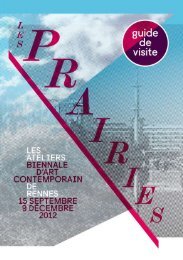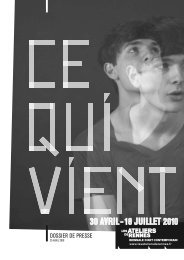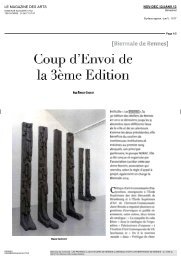Download here the Visitor's guide. - Les Ateliers de Rennes
Download here the Visitor's guide. - Les Ateliers de Rennes
Download here the Visitor's guide. - Les Ateliers de Rennes
You also want an ePaper? Increase the reach of your titles
YUMPU automatically turns print PDFs into web optimized ePapers that Google loves.
36<br />
<strong>Les</strong> Prairies's artists<br />
DOVE ALLOUCHE<br />
L’origine <strong>de</strong> la source I et II, 2012. Courtesy of <strong>the</strong> artist and galery Gau<strong>de</strong>l <strong>de</strong> Stampa, Paris.<br />
The medium of Dove Allouche's images present a puzzle. It is not clear how<br />
<strong>the</strong>y were ma<strong>de</strong> nor, in fact, what <strong>the</strong>y really show. The mystery arises from<br />
<strong>the</strong> sometimes-obsolete techniques that he uses. For <strong>Les</strong> Prairies Allouche<br />
has executed a series of ambrotypes, using a very old process, as well as two<br />
drawings. <strong>Les</strong> Pétrifiantes explores some special caves that Allouche used as<br />
natural 'dark rooms'. Just as stalactites and stalagmites are formed by slow<br />
sedimentation of calcium carbonate, <strong>the</strong> photographic technique (ambrotype)<br />
chosen by <strong>the</strong> artist for this series is a process of <strong>de</strong>posit and petrifaction. The<br />
ambrotype was invented in <strong>the</strong> mid-19th century. One si<strong>de</strong> of a glass plate is<br />
covered with a thin layer of collodion, and dipped in a silver nitrate solution.<br />
After exposure <strong>the</strong> plate is <strong>the</strong>n <strong>de</strong>veloped and fixed. One si<strong>de</strong> of <strong>the</strong> glass<br />
negative is coated with black varnish to restore <strong>the</strong> image. The process itself<br />
coinci<strong>de</strong>s with <strong>the</strong> subject of <strong>the</strong> image, i.e. matter being formed. The two<br />
drawings were executed in pen and ink and graphite from a 1940 stereoscopic<br />
plate. To give <strong>the</strong> impression of relief, <strong>the</strong> technique required a simultaneous,<br />
slightly off-centre double shot. The first drawing faithfully reproduces <strong>the</strong><br />
left-hand view; <strong>the</strong> second reproduces <strong>the</strong> negative of <strong>the</strong> right-hand view. The<br />
inversion gives a back and forth effect, an inverted <strong>de</strong>pth in which <strong>the</strong> Origine <strong>de</strong><br />
la source appears to be alternately behind us and in front of us.<br />
H. M. tr. J.H.<br />
Born in 1972 in Paris (France), w<strong>here</strong> he lives and works.<br />
Co-production<br />
<strong>Les</strong> <strong>Ateliers</strong> <strong>de</strong> <strong>Rennes</strong> 2012,<br />
Frac Bretagne.






